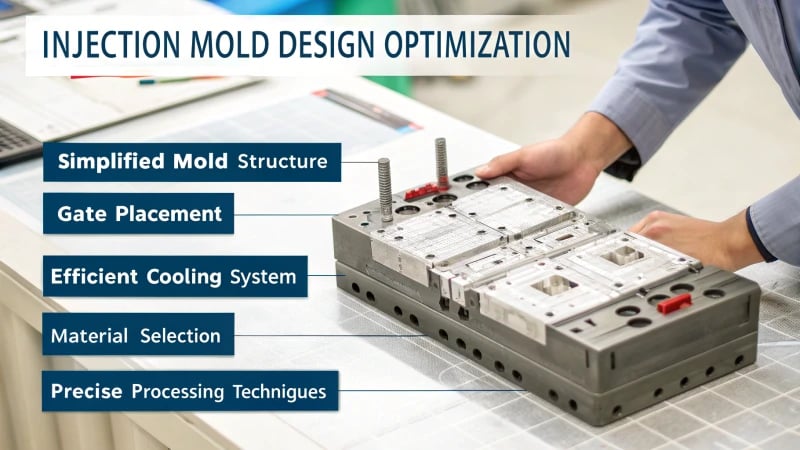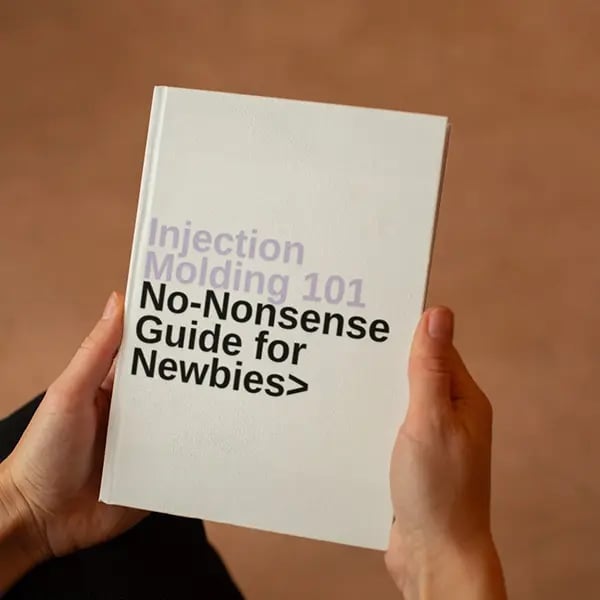
Ever wondered what makes those everyday plastic parts come to life so seamlessly? The secret lies in the art of injection mold design.
Key DFM principles for optimizing injection mold design include simplifying structure, strategic gate placement, effective cooling, selecting appropriate materials, and precise processing to enhance efficiency and reduce defects.
When I first started diving into the world of injection molding, these principles seemed like a complex puzzle. But as I began to piece them together, it became clear how each plays a critical role. Let me walk you through each one to give you a clearer picture. By focusing on simplifying mold structures and strategically placing gates, I learned how to make production not just efficient but also smoother. It’s all about finding that sweet spot where design meets functionality without compromising on quality. Over time, these practices have become my go-to strategies, significantly enhancing my design outcomes.
Simplifying mold structure enhances production efficiency.True
A simpler mold structure reduces complexity, improving efficiency.
Incorrect gate placement leads to reduced defect rates.False
Improper gate placement increases defect rates, not reduces them.
How Does Mold Structure Design Impact Efficiency?
Remember the last time you had a mold that just wouldn’t cooperate? It all comes down to design.
Efficient mold structure design enhances manufacturing by optimizing parting surfaces, slider movements, ejection systems, and gate positions, streamlining production, reducing costs, and improving product quality.

Parting Surface Design
Reflecting on my own experiences, I’ve learned the parting surface is like setting the stage for a play—it has to be just right. A well-aligned parting surface not only simplifies the mold but also trims down those pesky manufacturing costs1. I’ve seen firsthand how placing it at the maximum contour can make assembling the core and cavity shapes a breeze. It’s like putting together a puzzle with fewer pieces.
Slider and Inclined Top Design
Sliders and inclined tops are the unsung heroes when dealing with undercuts or side holes. I remember working on a project with deep side holes and realizing a slider with just the right stroke was my saving grace for smooth demolding. It’s crucial to ensure movement reliability—think of it as needing a dance partner who doesn’t miss a step. A sturdy guide mechanism, like wear-resistant blocks, ensures everything moves in harmony.
A table could illustrate:
| Feature | Purpose | Best Practice |
|---|---|---|
| Slider | Undercuts | Sufficient stroke |
| Inclined Top | Oblique undercuts | Precise angle matching |
Ejection System Design
Uniform ejection distribution is key. I’ve learned from experience that aligning ejection mechanisms with the product’s structural traits can prevent damage. For instance, flat parts benefit from edge ejectors, while those with reinforcing ribs need extra points near thicker walls. Choosing the right ejection method is like picking the right tool for the job—it makes all the difference.
Gate System Design
Selecting gate positions is akin to finding the perfect spot for a new plant in your garden—it’s all about ensuring balanced growth. Proper placement affects melt filling uniformity, which in turn impacts product quality. Using tools like mold flow analysis can guide you to determine optimal gate dimensions, reducing defects like shrinkage marks or insufficient filling.
Cooling System Design
Uniform cooling is crucial to avoid warping or dimensional deviations. The cooling channel layout should ensure even contact across all mold sections. I’ve experimented with different layouts—surrounding or spiral for complex molds—and found them effective in enhancing heat transfer efficiency.
For insights into cooling strategies, consider exploring advanced cooling techniques2.
Mold Material Selection and Processing Precision Control
Choosing the right material can feel like selecting the right car for a long road trip—durability and performance are non-negotiable. For high-output molds, materials like P20 steel ensure longevity. Processing precision is equally vital; high-precision demands, such as in optical lenses, necessitate micron-level accuracy. Advanced equipment like CNC machining centers maintain this precision through exact programming and control.
Exploring more about choosing mold materials3 that match your product needs can be enlightening. It’s fascinating how each element in mold design plays its part in achieving efficiency. With each project, I find myself more intrigued by the intricacies involved and the remarkable impact they have on manufacturing success.
A well-placed parting surface reduces manufacturing costs.True
Positioning the parting surface effectively simplifies mold design, lowering costs.
Cooling channels should always use water for high efficiency.False
Water is used for high conductivity, but oil is better for precise control.
How Does Gate System Design Impact Product Quality?
Ever wondered how a small tweak can drastically improve the quality of injection molded products?
Gate system design crucially affects injection molded product quality by ensuring uniform plastic melt flow, reducing defects, and enhancing appearance, thus achieving superior quality.

Understanding Gate System Design
I remember the first time I realized how crucial gate system design was. I was working on a project for a sleek new tech gadget, and despite our best efforts, the aesthetics weren’t quite right. The problem? Our gate system design.
By carefully adjusting how molten plastic entered the mold cavity, we managed to transform the uniformity and integrity of the final product. It was a game-changer, not just for the look but for the reliability of the gadget too.
Importance of Gate Position Selection
Deciding on gate positioning felt like solving a puzzle back then. It’s all about ensuring the melt fills evenly, avoiding weld lines and air entrapment. I found that placing gates on the symmetry axis worked wonders for symmetric products, while multi-point gates were a lifesaver for larger items.
| Product Type | Recommended Gate Position |
|---|---|
| Symmetric Parts | Symmetry Axis |
| Long Products | Multi-point to reduce flow path |
Impact on Product Appearance and Functionality
Appearance is everything in consumer electronics. I learned that strategically placing gates on non-visible surfaces or areas easy to finish helped maintain that polished look we all strive for. When it came to decorative or transparent items, latent or pin-point gates minimized those pesky gate marks.
Choosing the Right Gate Type and Size
Choosing the right gate type always feels like choosing the perfect tool for the job. For smaller parts, side gates provided stable melt flow, but when appearance was key, pin-point gates allowed for fast entry without compromising looks. A lesson I learned early on was that gate size is critical—too big, and you get shrinkage; too small, and you’re wrestling with filling issues.
Using mold flow analysis software4 was a revelation. It took the guesswork out of determining dimensions based on material fluidity and part size.
Real-World Application of Gate System Design
In one memorable project involving injection molded parts5, implementing a strategic gate design significantly improved product quality. Aligning with both aesthetic and functional needs ensured our final products didn’t just meet standards—they set new ones.
Take high-quality electronic components6, for example. Precise gate placement and sizing helped us dodge defects that could have compromised performance in consumer electronics. Through thoughtful design, we not only met customer expectations but exceeded them without inflating production costs. Employing CNC machining centers7 further honed this process, offering accuracy and control like never before.
Gate system design affects product quality in injection molding.True
The gate design determines melt flow, impacting uniformity and integrity.
Improper gate sizing has no impact on product defects.False
Incorrect sizing can cause shrinkage, flash defects, or filling issues.
Why is cooling system design crucial for mold performance?
Ever wondered why mold performance can make or break a product? It’s all in the cooling design!
A well-designed cooling system is vital for mold performance as it ensures even heat distribution, reducing warping, shortening cycle times, improving part quality, enhancing efficiency, and extending mold life.

The Role of Uniform Cooling
I remember when I first dove into the world of mold-making, realizing that uniform cooling was akin to finding the perfect balance in baking — too much heat here, not enough there, and you end up with a lopsided cake. In mold-making, a strategically planned cooling water channel layout8 is the secret to even temperature distribution across the mold cavity. This consistency prevents pesky issues like warping, which is crucial for maintaining the precision and dimensional accuracy we all strive for. For those intricate molds, using spiral or multi-layer designs can really nail that consistent cooling.
| Mold Type | Cooling Method |
|---|---|
| Simple | Straight Line |
| Complex | Spiral |
| Large | Multi-Layer |
Impact on Cycle Times
Who doesn’t love getting things done faster? Efficient cooling systems are like the turbo boost for production speed. By fine-tuning the flow rate, temperature, and pressure of the cooling medium, I’ve seen how manufacturers can slice cycle times significantly. It’s like the difference between slow-cooking a stew and using a pressure cooker — faster cycles mean more parts churned out in less time, bumping up productivity while cutting down costs. Adjusting these parameters not only speeds up cooling but also strikes that sweet spot between efficiency and quality.
Importance of Cooling Medium Selection
Choosing the right cooling medium9 felt like selecting the perfect wine to complement a meal. Water often tops the list due to its high thermal conductivity and affordability. But I learned the hard way that some molds are picky eaters; they need oil or special coolants for precise temperature control or to dodge rust issues.
Factors to consider when selecting a cooling medium include:
- Thermal Conductivity
- Cost
- Corrosion Resistance
Integration with Mold Structure
The harmony between the cooling system and mold structure can’t be overstated. I’ve seen designs where cooling channels interfere with components like ejection systems or sliders, causing more headaches than solutions. Proper integration ensures cooling channels enhance rather than hinder functionality or maintenance.
Strategically placing cooling channels near hotspots, such as ribs or thick-walled sections, can dramatically boost heat transfer efficiency.
Monitoring and Control Parameters
Keeping tabs on cooling medium flow10, temperature, and pressure is crucial. Too much flow can lead to cold material marks — think freezer burn on your leftovers — while too little flow might not cool enough.
Maintaining optimal parameters ensures consistent part quality and prolongs the mold’s service life. Real-time monitoring systems can provide invaluable insights to keep everything running smoothly.
These elements aren’t just side players; they’re central to achieving top-notch performance in mold-making.
Uniform cooling prevents mold warping.True
Even temperature distribution across the mold cavity avoids deformation.
Water is always the best cooling medium for molds.False
While common, water isn't ideal for molds needing precise control or rust resistance.
How do I choose the right materials for injection molds?
Choosing materials for injection molds feels like picking the right ingredients for a recipe that’s been passed down through generations. It’s all about balance, tradition, and a pinch of creativity.
Select injection mold materials by weighing durability, machinability, and cost. High-grade steels like P20 and H13 provide robust performance, while aluminum alloys are cost-effective for smaller production runs.

Understanding Mold Material Properties
When I first started working with injection molds, I realized that picking the right material is like finding the perfect pair of shoes—it needs to fit just right for comfort and longevity. Here’s what I learned:
-
Durability: If you’re cranking out high volumes, materials like P20 or H13 steel are your go-to. They’re tough cookies, offering high hardness and strength.
-
Machinability: Time is money, and some materials are easier to machine than others. For instance, when I worked on a small batch project, aluminum alloys saved me both time and costs.
-
Heat Treatment: It’s like marinating meat before cooking—proper heat treatment enhances the material’s properties, ensuring your mold maintains its shape over time.
Evaluating Cost-Effectiveness
Budgeting is always tricky. Here’s a snapshot of what different materials bring to the table:
| Material | Use Case | Cost Level |
|---|---|---|
| P20 Steel | High-volume, precise molds | High |
| H13 Steel | High-pressure molding applications | High |
| Aluminum | Prototypes, low-volume production | Moderate |
| Zinc Alloy | Low-cost, non-critical applications | Low |
Balancing upfront costs with long-term benefits is key. From my experience, investing in quality materials often pays off in terms of reduced maintenance and longer mold life.
Impact of Mold Structure Design
Designing a mold is an art. I once struggled with a complex mold until I learned to simplify the parting surface design. Placing it at the maximum contour not only reduced complexity but also made processing and assembly easier.
- Demoulding Considerations: Positioning parting surfaces strategically minimizes visible marks on surfaces. For products with side holes, using sliders ensures smooth demoulding.
For more on simplifying mold structure11, consider consulting resources that discuss parting surface design and its influence on production efficiency.
Cooling System Design and Its Influence
The cooling system is like the AC in your car—essential for maintaining an even temperature. An evenly distributed cooling channel layout prevents defects like warping.
- Choosing Cooling Medium: While water is common due to its efficiency, sometimes specific cases might require alternatives like oil or air.
Selecting the right material not only impacts initial costs but also affects the overall efficiency and durability of your production process. It’s a journey of trial, error, and triumphs—one that I’ve grown to appreciate over the years.
P20 steel is suitable for high-volume molds.True
P20 steel offers high hardness and strength, ideal for repeated use.
Aluminum is the most expensive mold material.False
Aluminum is moderate in cost, suitable for low-volume production.
How Can I Ensure Precision in Processing?
Precision in processing isn’t just a technical challenge—it’s an art that requires patience and skill. Every detail matters, from design to cooling, making each step a vital piece of the puzzle.
Ensure processing precision by focusing on strategic mold design, optimal cooling, and advanced machining. Key practices include suitable material selection, efficient gate system design, and utilizing cutting-edge technologies.

When I first dove into the world of mold design, I quickly learned that precision was more than just a buzzword. It was the difference between a product that met expectations and one that exceeded them. Let’s start with the mold structure design.
Mold Structure Design
Parting Surface Design: One time, I was working on a mold for a consumer electronics part and realized how crucial the parting surface’s position was. By simplifying the structure, I made assembly and processing much easier. Avoiding complex surfaces like twisted lines can be challenging but worthwhile for reducing costs and easing assembly. Consider product appearance and demoulding12 by placing parting surfaces where they minimally impact aesthetics.
Slider and Inclined Top Design: Imagine trying to get a cake out of a pan without greasing it—sliders in mold design are like that essential layer of butter. For those tricky undercuts or side holes, reliable guides ensure everything moves smoothly, which means fewer headaches during demolding.
Ejection System Design
Uniform Ejection Distribution: I remember the first time I misjudged ejection points, resulting in product damage due to uneven force. Placing ejectors strategically near thicker areas helped mitigate such risks and improved the overall product quality.
Appropriate Ejection Methods: Choosing the right ejection method is like picking the right tool for a job. For parts with high surface quality needs, push plates often work wonders.
Gate System Design
| Gate Position | Best Practices |
|---|---|
| Uniform Melt Filling | Position gates to enable even cavity filling and avoid defects like weld marks. |
| Appearance Consideration | Avoid gates on key functional or aesthetic areas, opting for latent gates if necessary. |
Selecting the right gate type is crucial. It’s about balancing appearance with functionality—side gates are great for medium-sized parts, while pin-point gates13 fit high-quality appearance needs perfectly.
Cooling System Design
Cooling Water Channel Layout: One of my mentors once told me that cooling is half the battle in mold design. It’s true; ensuring uniform cooling prevents warping. For complex shapes, a spiral or multi-layer channel layout can maintain consistency across surfaces.
Cooling Medium and Parameter Control: Water is usually my go-to for cooling due to its thermal properties. Controlling flow rates is key to avoiding defects like cold material marks caused by excessive cooling.
Mold Material Selection and Processing Precision Control
Material Selection: Choosing the right material can make or break a project. For high-output molds, durable materials like P20 steel are invaluable. But always consider machinability to keep manufacturing cycles efficient.
Processing Precision Control: Advanced technologies like CNC machining ensure high processing accuracy, which is crucial for complex shapes. It’s these technologies that allow me to meet tight tolerances consistently.
Parting surfaces should avoid twisted lines.True
Twisted lines increase processing difficulty, complicating mold design.
Water is rarely used as a cooling medium in molds.False
Water is commonly used due to its excellent thermal conductivity.
Conclusion
Key DFM principles for optimizing injection mold design include simplifying structures, strategic gate placement, effective cooling systems, material selection, and precise processing to enhance efficiency and reduce defects.
-
Understanding parting surface design can significantly reduce manufacturing costs by simplifying the mold structure. ↩
-
Learning advanced cooling techniques helps optimize mold performance by ensuring uniform temperature distribution. ↩
-
Choosing appropriate mold materials enhances durability and efficiency tailored to specific product needs. ↩
-
Discover software tools to optimize gate dimensions for better product quality. ↩
-
Learn how strategic gate design improves injection molded part quality. ↩
-
Explore how precise gate design enhances electronic component performance. ↩
-
Uncover how CNC technology improves gate accuracy in molds. ↩
-
This link explores why uniform cooling is essential in preventing defects like warping, ensuring high-quality molded parts. ↩
-
This link provides insights on selecting suitable cooling mediums based on thermal properties and cost-effectiveness. ↩
-
This link offers methods for optimizing flow parameters to ensure efficient cooling without compromising part quality. ↩
-
Discover techniques to simplify mold structures by optimizing parting surface design. ↩
-
Understand how parting surfaces affect product appearance and demoulding efficiency. ↩
-
Learn why pin-point gates are preferred for high-quality appearance products. ↩






